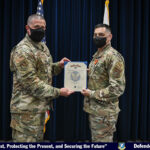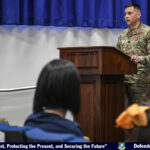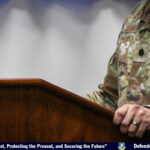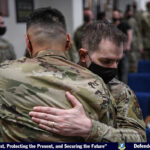Yokota Air Base Japan — It was about 5 a.m. when, then 1st Lieutenant Murray woke up to news that members from one of his squads outside the wire were to be medically evacuated.
That morning a five-ton gun truck was involved in an accident while providing security for a convoy. The five-ton gun truck rolled over three times, breaking the gun box off of the roof and ejecting then Senior Airman Soto. All three Airmen in the vehicle suffered injuries — some critical.
“Critical was the terminology used to say they needed to be [medically evacuated] immediately,” said, now Lt. Col, Jonathon Murray, 374th Security Forces Squadron commander. “We had no way of knowing at the time how life-threatening the injuries were.”
Murray and his teammates were a mix of mostly security forces, vehicle operators and vehicle maintenance Airmen. They also had a few communications, intelligence and personalist Airmen.
It was 2005 and their mission was to ensure combat sustainment supplies and personnel move efficiently and securely across the different forward operating bases in the area. These Airmen were deployed to augment the 561st Combat Support Battalion, 101st Airborne Division out of FOB Speicher, Iraq.
As a flight commander, Murray led four squads of 13 personnel operating four gun trucks, each commanded by a technical sergeant, responsible for ensuring the safe return of the squad and supplies every time they went outside the wire.
“Most of our missions were led by NCOs who performed flawlessly. It’s amazing what our Airmen can do when we trust them even in the most dangerous of missions, such as providing security for convoys in Iraq” Murray said.
Their battlefield was the main supply route Tampa, which was the coalition name for the highway running from the border of Kuwait to northern Iraq.
“There was a source of pride in us being Air Force,” Murray said. “We painted subdued Air Force symbols on our strike plates to make sure people knew it was an Air Force convoy coming through. We took a lot of pride in the fact that we were doing an Army mission and we were really good at it.”
Anytime there was a potentially traumatic incident such as a hostile engagement or in this case the vehicle roll over, the squad was grounded and required to go see combat stress, the Army version of mental health. After that, leadership would make a decision as to whether the team was ready to go outside the wire again, Murray said.
As the squad received their clearance to go back outside the wire, Murray led the team as the convoy commander with Tech. Sgt. Allen Jones and Staff Sgt. Shane Gullick in his vehicle.
Their mission was to escort food and supplies from FOB Speicher to Balad Air Base down MSR Tampa.
“The vast majority of missions are extremely boring,” Murray said. “Which is a good thing. It means nothing happened and the mission was successful.”
It was 10 p.m. There was very little ambient light other than the moon. Murray and Jones’ convoy was about 30 minutes from the end of their route when a crackled warning came over the radio from the lead gun truck.
“Gun Truck 3, this is Gun Truck 1, Iraqi forces at the checkpoint ahead are jumping into their bunkers.”
“All gun trucks, all gun trucks,” Jones’ voice came over the radio from his position next to Murray. “Increase space to 100 meters.”
Spacing the convoy out reduces the possibility of multiple casualties in the event of an improvised explosive device.
An explosion hit the left side of semi-truck directly in front of Murray’s gun truck.
“IED! IED! IED!” The crew immediately called over the radio. Murray maneuvered his truck to cover the left side of the damaged vehicle in case it wasn’t an improvised explosion device, but directed fire.
Behind Murray, Gullick was in the gunner position with an M240B, scanning for the threat and providing updates.
“I got nothing.”
“I got nothing.”
“I got nothing,” he said.
“Split the convoy,” Murray said.
Jones gave the order over the radio. “Gun truck three has lead for the rear. Gun truck one and gun truck two, keep pressing.”
Murray’s gun truck moved up to block off the highway in front of the damaged vehicle, with the fourth gun truck blocking the rear. Gun trucks one and two did the same 800 meters up the road with their escorted vehicles, creating two targets for the enemy.
Gun truck one reported small arms fire over the radio shortly after blocking off their portion of the road. Their 50 caliber machine gun could be heard in the background of the transmission.
“We couldn’t leave the rear part of the convoy to help, and we were unsure if we could move, because we did not know what just hit us,” Murray said. “Sergeant Jones was trying to message the battlespace owners via satellite instant messaging to request support from QRF [quick reaction force], but all communications were out.”
With no response via radio or satellite from allies in the area, Murray decided he had to get the convoy moving. He stepped out of his truck and sprinted to the damaged semi-truck they were escorting.
It was engulfed in flames.
Crates of soda cans on the back of the truck were heating up and exploding, sending whistling cans shooting off in different directions.
The driver of the truck, a civilian contractor, had been killed by the explosion and impaled by what appeared to be part of the driveshaft of the vehicle.
With the truck disabled and the driver dead, Murray made the decision to move the rear two guns trucks up to join the front two and provide additional firepower to the fight.
As Murray got back into his gun truck, he radioed to the rest of the team, “Gun truck one, this is Jumper One Bravo, we’re coming up from your 7 o’clock. Continue engaging, we’ll be there in a minute,” Murray elbowed Gullick’s legs behind him, alerting him to prepare for engagement.
As they approached, they could see muzzle flashes in the darkness and tracer rounds from the lead gun truck’s 50 caliber machine gun going out toward the flashes.
Behind them, gun truck four reported another explosion on the disabled truck they left behind — this time from the right side.
With fire coming from multiple directions, the fourth gun truck stayed positioned toward the rear while the other three engaged the muzzle flashes in the darkness. Gullick’s M240B machine gun added its voice to the 50 caliber’s.
“There’s nobody on this earth who can convince me that Sergeant Gullick and gun truck one’s lead gunner didn’t just save my, and a lot of other people’s lives that night,” Murray said. “I consider us very lucky.
As Murray was handing more ammo to Gullick, a radio call came through the secure frequency.
“QRF coming from your 12 o’clock. Cease fire! Cease fire! We’re engaging!”
An M2 Bradley arrived and fired off one 25 mm burst.
Everything stopped and a sudden silence cut the chaos short.
The QRF helped secure the scene while Murray’s truck returned to the contractor’s vehicle to recover his remains before heading to Balad Air Base.
“We take care of our own, yes,” Murray said. “But often, people don’t think about the contracted workers that help us.
“We take care of them too.”
After the ambush, it was determined the explosions that hit the semi-truck were not IEDs, but rocket propelled grenades fired from both the left and right sides of the convoy. Murray and his team were the targets of a timed ambush.
In the weeks following the ambush, Jones and Murray would sit and talk. Murray said he was struggling to come to terms with the ambush. Jones would often encourage him to go with him to see the chaplain.
Sometimes they would talk about what happened that night. Sometimes they would say nothing at all, either way, they helped each other process what they’d been through.
After about a week of this, Jones looked at Murray and said, “L.T., I’m going to the chaplain and you’re going to come with me.”
“Seeing your troops get hurt. Having someone die in your convoy. Fighting for not only your life but your entire team’s life. It makes you realize how vulnerable we are as human beings,” Murray said. “Those are tough realities to deal with for anybody.
“Seeing your Airmen come back on a medical helicopter, then a couple weeks later fighting off an ambush — the sounds and smells of it get ingrained into your brain.”
Murray and the team were eventually cleared by combat stress and spent the remaining four months of their tour running security for convoys in Iraq.
“I’m extremely grateful to that entire team,” Murray said. “On that night, we executed our mission exactly how we trained and fought off a complex attack with minimal losses.”
The Air Force Combat Action Medal was created in 2007 to recognize Airmen who were in direct combat. Murray and his team did not submit for the medal.
“Each member had their own reason as to why,” Murray said, “We are a team, If they did not submit, then neither would I.”
Now, Master Sgt. Soto is stationed at Dyess Air Force Base, Texas and Master Sgt. Gullick is stationed at Hurlburt Field, Florida. Jones retired as a Master Sergeant.
In 2019, Gullick reached out, seeking help in submitting for his AFCAM. Because of the time that had passed, an extensive waiver process would be needed.
The team and their respective offices today spent the next two years working through the approval process.
“These medals represent validation and recognition by the Air Force of what we went through,” Murray said. “This story is one of perseverance not only in combat but also in the fight for the recognition of Airmen as it took many people to get these medals approved.”
After 16 years, Master Sgt. Gullick and Lt. Col. Murray were awarded the AFCAM early 2021.
“There was no hero in this story,” Murray said. “It was just Air Force people performing ground combat operations, using tactics and training to get through an enemy ambush
By Staff Sgt. Kyle Johnson, 374th Airlift Wing Public Affairs / Published June 23, 2021




